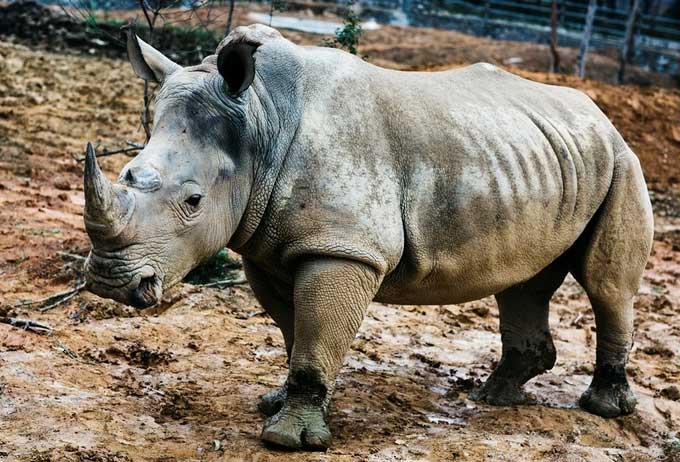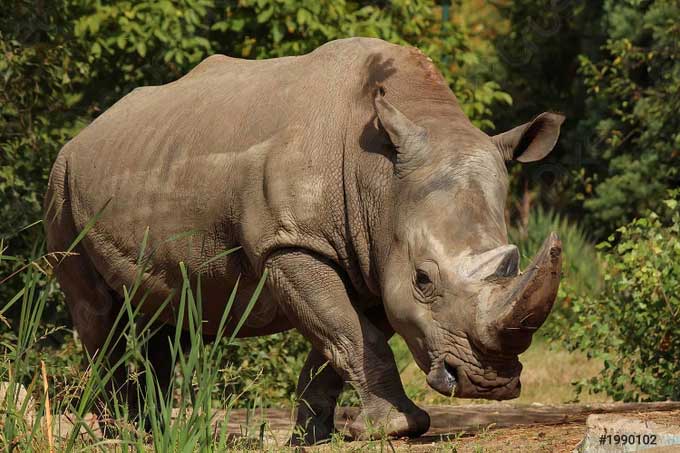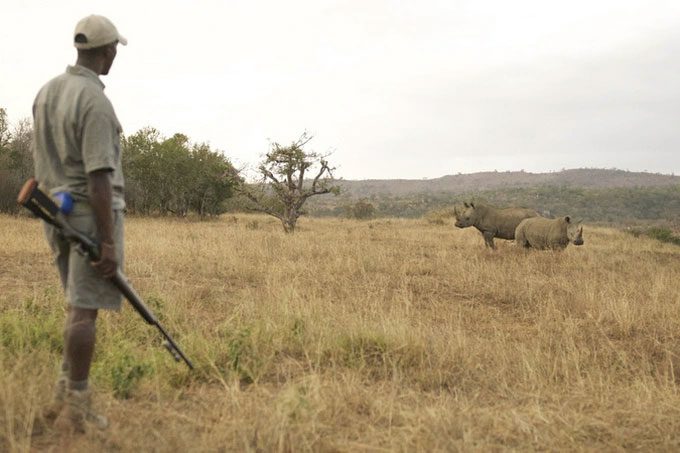The Southern White Rhinoceros is considered one of the most endangered species in the world.
In Vietnam, rhinoceroses have long been extinct in the wild. Currently, some ecological parks keep rhinoceroses for tourist viewing.
How Rare is the Death of a Two-Horned Rhinoceros?

Rhinoceros raised in an ecological park in Dien Lam, Dien Chau district. (Photo: M.T).
The leader of the Nghe An Forest Protection Department stated that the rhinoceroses that died in the Muong Thanh Dien Lam Ecological Park are two-horned rhinoceroses, imported from Africa to Vietnam, each weighing over a ton.
They are also known as Southern White Rhinoceroses (scientific name: Ceratotherium simum), which is the most common subspecies of surviving rhinoceroses today. This species is sometimes referred to as the square-lipped rhinoceros due to their protruding lips that help them graze on short grasses in savanna regions.
As of now, the Southern White Rhinoceros is still regarded as one of the largest and heaviest land animals in the world. According to data from Wikipedia, female rhinoceroses weigh an average of 1,700 kg, while males can weigh up to 2,300 kg. Their head and body length can reach up to 4 meters.
The diet of rhinoceroses mainly consists of leaves, tubers, and roots from forest plants. They prefer to live solitary in ancient forests within damp valleys or muddy areas.

A white rhinoceros in the wild. (Photo: Crushpixel).
On the snout of the rhinoceros are two horns. The front horn is larger, averaging 60 cm in length, and can reach up to 150 cm. Females typically have longer horns, but they are thinner compared to those of males.
In the wild, this species has virtually no natural enemies. However, they are continuously threatened by illegal poaching. The primary target of poachers is the rhinoceros horn.
The True Value of Rhinoceros Horn
According to the newspaper Le Parisien, the current price of rhinoceros horn is higher than that of drugs and gold. In today’s market, the price for 1 kg of rhinoceros horn ranges from 50,000 to 100,000 euros, depending on buyer demand.
This high value is attributed to the use of rhinoceros horn in traditional medicine, often touted as a “cure-all.” However, in reality, no scientific studies have confirmed the accuracy of these claims.
Analysis shows that rhinoceros horn is composed solely of keratin, a protein found in hair, nails, and animal hooves, and has no unique properties.
Therefore, the long-held value of rhinoceros horn may simply be a myth and has no actual exchange value.
Efforts to “Revive” the White Rhinoceros

White rhinoceros is strictly protected in reserves in Africa. (Photo: Getty).
The Southern White Rhinoceros was once considered one of the most endangered species in the world. This species was on the brink of extinction with fewer than 20 individuals remaining in a reserve in South Africa around the early 20th century, late 19th century.
“For a time, everyone thought that rhinoceroses could not survive due to poaching,” said Tumelo Matjekane, manager of a nonprofit organization supporting the establishment of reserves in Southern Africa.
However, through many strong conservation efforts, small populations of white rhinoceroses have gradually recovered. The most notable example is the Hluhluwe Imfolozi Park (HiP) in KwaZulu-Natal, South Africa, which is at the forefront of combating criminal gangs to protect rhinoceroses.
To achieve this, HiP has gradually transformed into the first “Smart Park” in Africa, integrating surveillance technology, including smart fencing installed for protection along with camera traps.
This advanced technology has consumed thousands of USD funded for the rhinoceros protection program, but its results have satisfied leaders greatly.
In 1980, the recorded number of white rhinoceroses surged to 840 individuals. By 2011, the population of this species continued to increase to over 17,000, primarily distributed in HiP.
As of now, according to Save the Rhino, a rhinoceros conservation organization, the population of Southern White Rhinoceroses has rebounded to over 20,000 individuals worldwide after a period on the brink of extinction.


















































